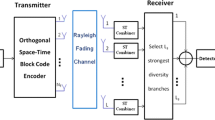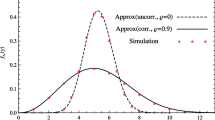Abstract
In this paper, the performance analysis of multi-antenna MIMO systems with variable-power (VP) adaptive modulation and space-time coding is presented. The fading gain value is partitioned into a number of regions by which we decide the transmission power according to the region the fading gain falls in. The optimum fading gain region boundaries (switching thresholds) for maximizing spectrum efficiency (SE) under a target BER and average power constraint are derived. It is shown that the Lagrange multiplier in the constrained SE optimization will be unique if the existence condition for multi-antenna systems is satisfied, and is unique for single antenna systems. A practical iterative calculation method based on Steepest Descent Algorithm for finding the Lagrange multiplier is proposed. With the switching thresholds, the closed-form expressions of the SE and average BER, respectively for VP system and constant-power (CP) system are achieved. Simulation results for SE and average BER are in good agreement with the theory analysis. The results show that VP adaptive modulation with space-time coding provides better SE than the counterpart with CP under a target BER and average power constraint.
Similar content being viewed by others
References
Svensson A, Oien G E, Alouini M S, et al. Special issue on adaptive modulation and transmission in wireless systems. Proc IEEE, 2007, 95: 2269–2273
Goldsmith A J, Chua S G. Variable-rate variable-power MQAM for fading channels. IEEE Trans Commun, 1997, 45: 1218–1230
Ko Y, Tepedelenlioglu C. Orthogonal space-time block coded rate-adaptive modulation with outdated feedback. IEEE Trans Wirel Commun, 2006, 5: 290–295
Chung S T, Goldsmith A J. Degrees of freedom in adaptive modulation: a unified view. IEEE Trans Commun, 2001, 49: 1561–1571
Alouini M S, Goldsmith A J. Adaptive modulation over Nakagami fading channels. Wirel Pers Commun, 2000, 13: 119–143
Tan P H, Wu Y, Sun S. Link adaptation based on adaptive modulation and coding for multiple-antenna OFDM system. IEEE J Select Areas Commun, 2008, 26: 1599–1606
Wang J B, Chen H M, Chen M, et al. Cross-layer packet scheduling for downlink multiuser OFDM systems. Sci China Ser F-Inf Sci, 2009, 52: 2369–2377
Conti A, Win M Z, Chiani M. Slow adaptive M-QAM with diversity in fast fading and shadowing. IEEE Trans Commun, 2007, 55: 895–905
Jaime G D G, Leao R M M, Silva E, et al. User level fairness of a multirate 3G technology (EVDO) with application to digital TV return channel technology. IEEE Trans Broadcast, 2008, 54: 578–589
Sampei S, Harada H. System design issues and performance evaluations for adaptive modulation in new wireless access systems. Proc IEEE, 2007, 95: 2456–2471
Tarokh V, Jafarkhani H, Calderbank A R. Space-time block coding for wireless communications: performance results. IEEE J Select Areas Commun, 1999, 17: 451–460
Shin H, Lee J H. Performance analysis of space-time block codes over keyhole Nakagami-m fading channels. IEEE Trans Veh Tech, 2004, 53: 351–362
Yu X B, Bi G G, Xu W Y. Low-complexing distributed differential space-time coding scheme for amplify-and-forward cooperative networks. Sci China Ser F-Inf Sci, 2009, 52: 1418–1427
Maaref A, Aissa S. Rate-adaptive M-QAM in MIMO diversity systems using space-time block codes. In: Proc IEEE Int Symp Personal, Indoor Mobile Radio Communication. Barcelona, Spain, 2004. 2294–2298
Carrasco H M, Fonollosa R J, Delgado-Penin J A. Performance analysis of space-time block coding with adaptive modulation. In: Proc IEEE Int Symp Personal, Indoor Mobile Radio Communication. Barcelona, Spain, 2004. 493–497
Dong J, Zhou Y, Li D. Combined adaptive modulation and coding with space-time block code for high data transmission. In: Proc IEEE Communication Technology Conference, Beijing, China, 2003. 1476–1479
Duong D V, Oien G E. Optimal pilot spacing and power in rate-adaptive MIMO diversity systems with imperfect CSI. IEEE Trans Wirel Commun, 2007, 6: 845–851
Zhou Z, Vucetic B, Dohler M, et al. MIMO systems with adaptive modulation. IEEE Trans Veh Tech, 2005, 54: 1828–1842.
Gjendemsj H. Optimal power control for discrete-rate link adaptation schemes with capacity-approaching coding. In: Proc IEEE Global Telecommunication Conference. St. Louis, Missouri, 2005. 3498–3502
Proakis J G. Digital Communications. 4th ed. New York: McGraw-Hill, 2001
Xia P, Giannakis G B. Design and analysis of transmit-beamforming based on limited-rate feedback. IEEE Trans Signal Process, 2006, 54: 1853–1862
Lau V K N, Liu Y, Chen T A. On the design of MIMO block-fading channels with feedback-link capacity constraint. IEEE Trans Commun, 2004, 52: 62–70
Tan L, Zhu P C, Wang Y, et al. Adaptive modulation based on finite-rate feedback in broadcast channels. IEEE Trans Wirel Commun, 2008, 7: 4449–4454
Giannakis G B, Liu Z, Ma X, et al. Space-Time Coding for Broadband Wireless Communications. New York: Wiley, 2007
Gradshteyn I S, Ryzhik I M. Table of Integrals, Series, and Products. 5th ed. San Diego, CA: Academic, 2000
Simon M K, Hinedi S M, Lindsey W C. Digital Communication Techniques Signal Design and Detection. Englewood Cliffs, NJ: Prentice-Hall, 1995
Author information
Authors and Affiliations
Corresponding author
Rights and permissions
About this article
Cite this article
Yu, X., Shi, H. Performance analysis of variable-power adaptive modulation in space-time block coded MIMO diversity systems. Sci. China Inf. Sci. 53, 2106–2115 (2010). https://doi.org/10.1007/s11432-010-4060-3
Received:
Accepted:
Published:
Issue Date:
DOI: https://doi.org/10.1007/s11432-010-4060-3




